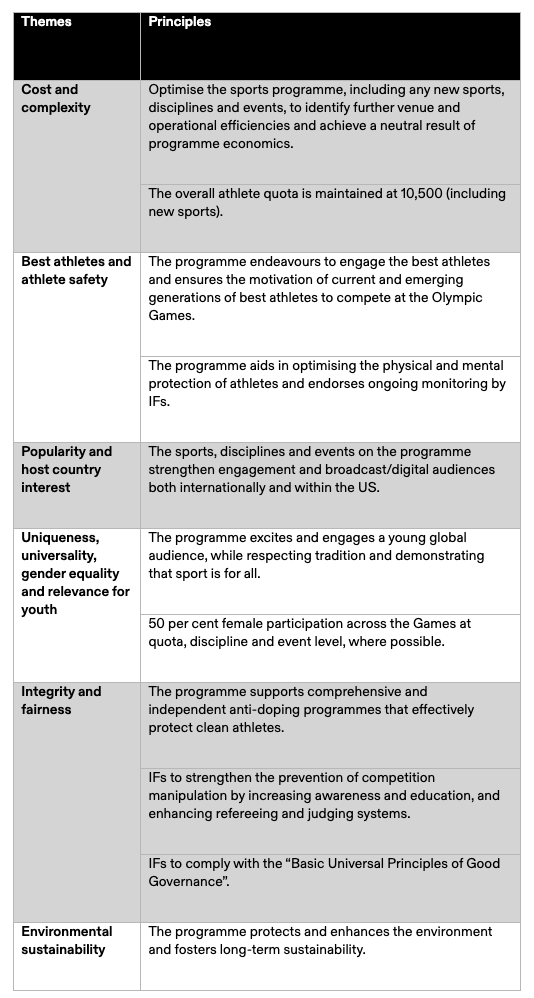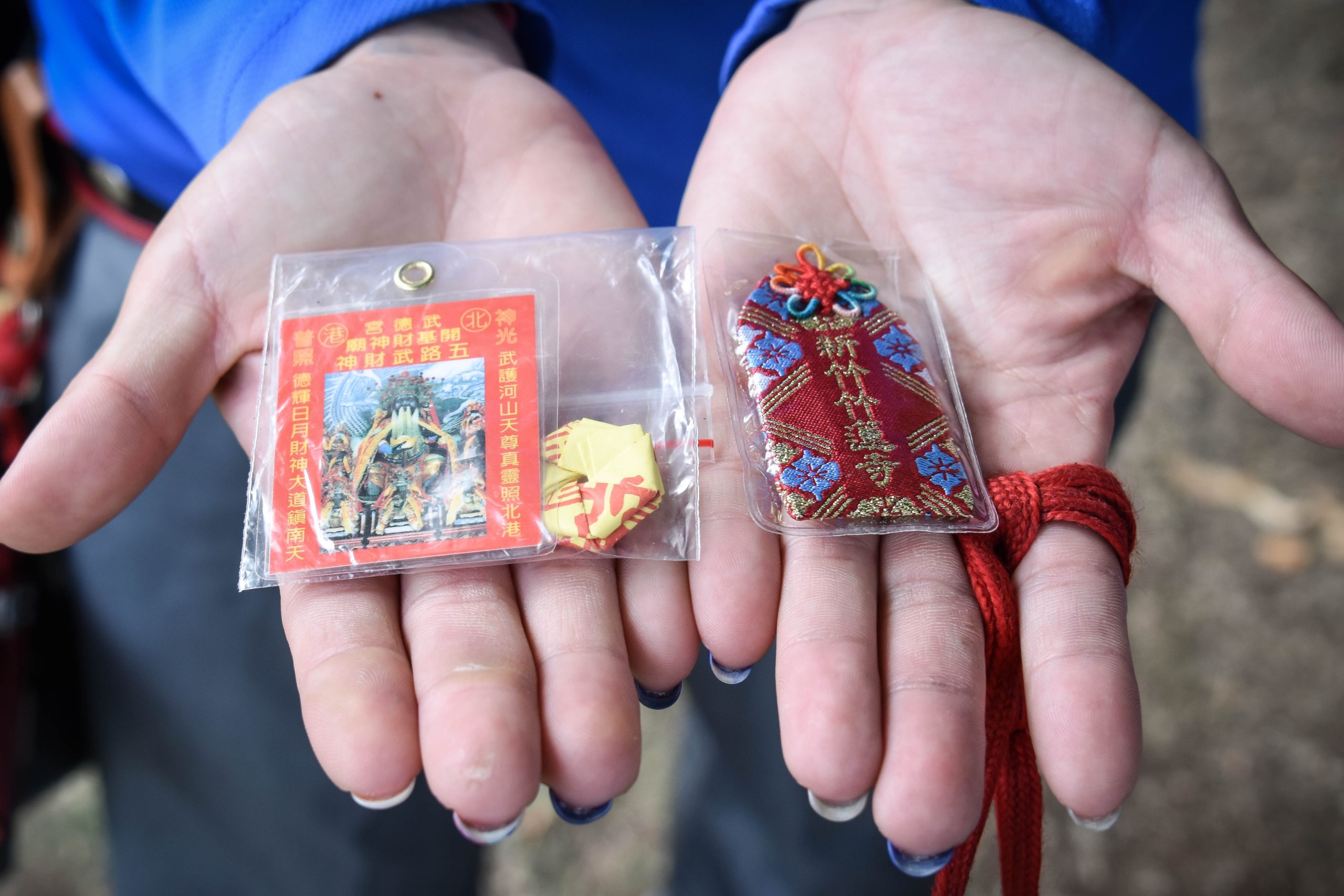So the glorious future for compound archery as an Olympic sport has been ground firmly into the dust, for now – and maybe forever. The news came via a public IOC missive that didn’t even bother to mention the...
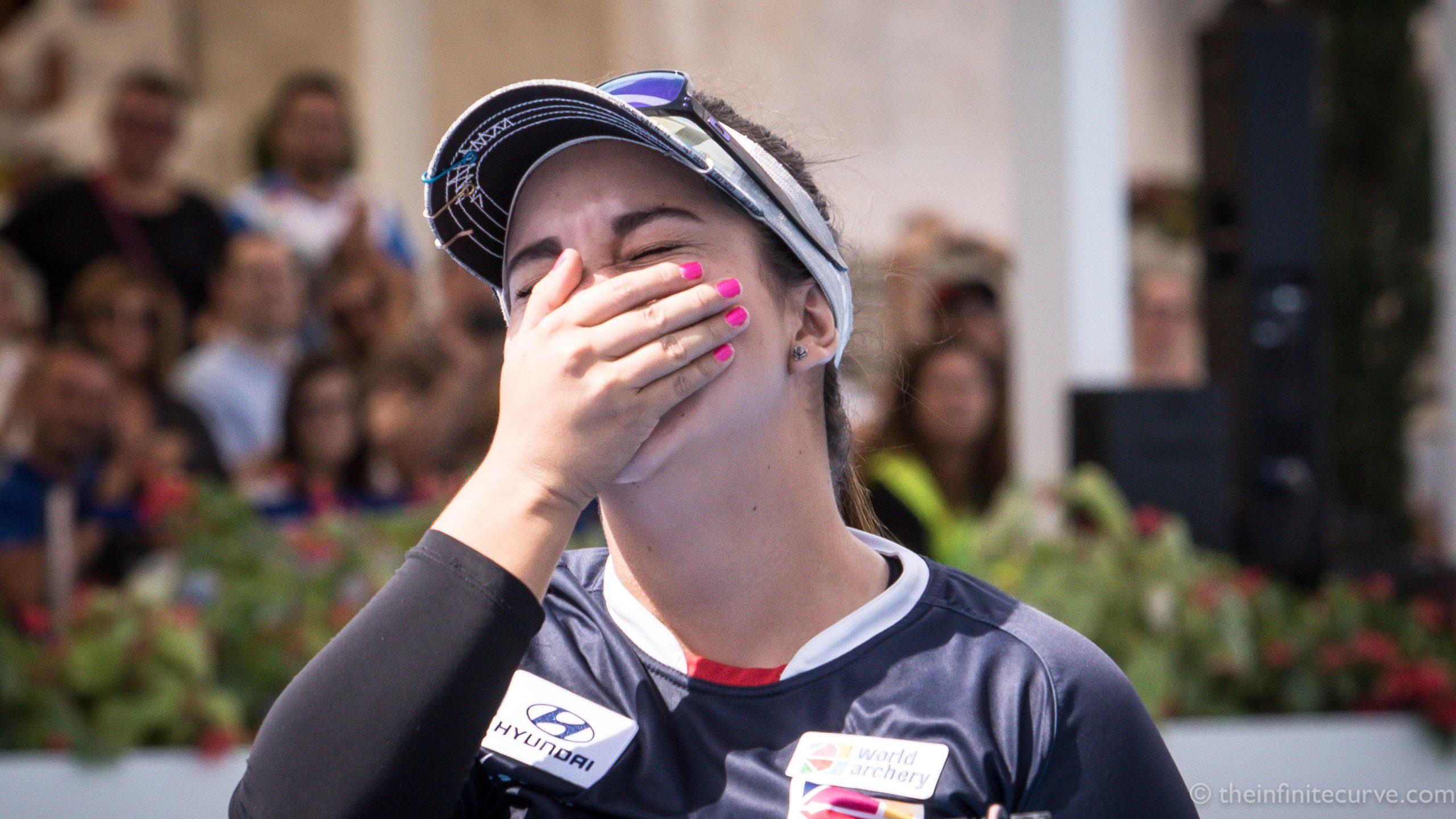
So the glorious future for compound archery as an Olympic sport has been ground firmly into the dust, for now – and maybe forever.
The news came via a public IOC missive that didn’t even bother to mention the sport; not even a ‘thanks but no thanks’. It merely made it clear that none of the Olympic sports that had requested an addition to their discipline programmes would be getting them – apart from rowing.
Overall, the discipline review highlighted various opportunities that exist for the IOC, LA28 and the IFs to work together to reduce the cost and complexity of the sports programme at the Games.
Following a holistic review of all existing and new disciplines proposed by the respective IFs with sports on the LA28 programme, only one change has been made to the discipline programme compared to Paris 2024, with beach sprint rowing, a format of the coastal rowing discipline, included on the Olympic programme for the first time. It will replace the lightweight double sculls (men 2x and women 2x) events. The inclusion of beach sprint rowing is the outcome of a decade-long development of coastal rowing with the active support of rowing communities across the world. The new discipline will share an existing Games venue, to be determined, with another sport.
(NOTE: ‘IFs’, by the way, refer to ‘International Federations’, which are the overall governing bodies of international sports – such as World Archery, World Rowing etc.)The only sport that got what it wanted for LA was rowing, with the inclusion of a single coastal rowing event, but as you can see, this was at the expense of another discipline. Coastal rowing has indeed been growing as a sport worldwide, but there isn’t any particular reason why that deserves to be there more than compound.
As to why rowing got what it wanted, it has been speculated that this was a bone thrown because of the massive disruption caused by holding the LA rowing events on a course that is 1500m long, rather than the usual 2km – the distance that has been standard since the 1912 Olympics in Stockholm (bar 1948). The decision was taken in order to make the Games more ‘compact and economical’; which is not an unreasonable path.
Any new disciplines or events proposed (note the difference between new events and new sports, which take different pathways to arriving at the Games) must make it past a set of criteria set down by the IOC which include cost, athlete quotas, popularity, universality, and governance:
This list, however, is essentially an impossible list of hurdles; ultimately it’s so wide-ranging that pretty much any new sport or discipline could fall foul of it.
It’s long been known that compound has issues with universality, number four on the list above. Compound archery remains popular in North America and Europe, with smaller pockets of competitors, elite and recreational, spread unevenly around the rest of the world. Again much progress has been made by WA, and compound is now a full part (more or less) of all three major continental meets: the Pan-American Games, Asian Games, European Games. However archery was left out of the latest African Games and hasn’t returned to the Commonwealth Games, either.
It has also had issues with equality; both in terms of equal numbers of men and women competing, strength in depth, and differing levels of prize money, especially in North American tournaments; the only circuit on which compound archers are able to earn a professional living outside Korea.
It’s also not really hitting the ‘sexy youth wow’ factor that the sports industrial complex is forever looking for. Tom Dielen set it all out for Bow International magazine back in 2019, and it’s still worth a read to explain the very complex issues, which get solved at a glacial pace measured over decades.
Still, the biggest stumbling block of all might be the athlete cap, which it has been firmly re-iterated is carved in stone at 10,500 athletes, a measure enacted decades ago in order to help reduce the spiralling costs of hosting the Games and upheld ever since.. If archery added another 32 athletes – 16 men and 16 women – as an elite indoor compound competition, it seems increasingly likely it would have to lose 32 from the 128 in the recurve competition, which would absolutely change the character of the competition, completely.
Athletes compete in multiple disciplines in all the big summer Olympic sports: athletics, swimming, gymnastics, diving, cycling, etc. as well as things like fencing at the Paralympics. The IOC, sports authorities and successive organising committees must look at archery and say ‘why do you need different athletes to do something so similar?’.
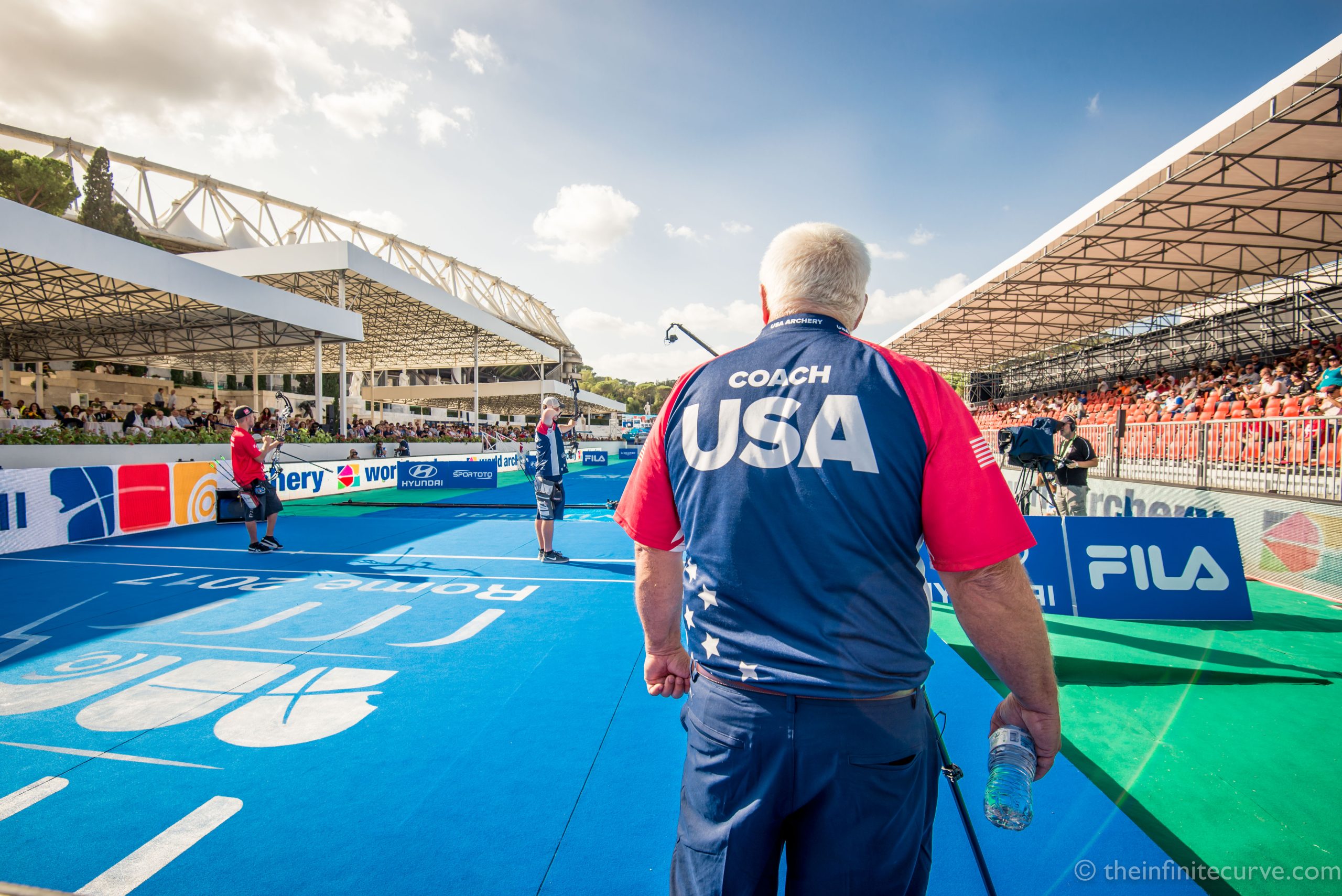 The USA: great at compound, but it wasn’t enough
The USA: great at compound, but it wasn’t enough
It’s also possible the indoor format simply didn’t look exciting enough; especially if there wasn’t a Vegas-style shootdown involved. It’s also possible it simply wasn’t different enough from recurve, especially with the requirement for more places. It’s possible the potential numbers (and thus income) were good, and growing, but not just big enough to push it over the line.
Even so, the case was good, so perhaps the real reason is something behind the scenes. It must be pretty galling for World Archery, considering the amount of work they have put in over many years to get to this point, only to face an almost blanket ban on new disciplines across the board for LA. This culminated in some of the most spectacular media numbers for the sport in Tokyo, compared to other sports. They are riding high in the pantheon. And now, there is not even an apparent pathway for introducing compound at Brisbane in 2032, either. What would need to change to make it happen?
It’s sad to say, but unfortunately compound is an insignificant part of a great global game of sport, money and politics. The big headline news this week is, of course, not the lack of compound, but the introduction of five new one-off Olympic sports for LA: baseball, cricket, lacrosse, flag football and squash. Baseball was part of Tokyo and is obviously popular in North America, while flag football – essentially, a junior version of American football – will presumably pick up some numbers. Lacrosse has an indigenous sports angle which you will be hearing plenty about in a few years time. And squash has been angling to get into the Olympics for many decades.
But cricket is the interesting one. Cricket is there in order to tap into new markets, specifically India. It’s news that hasn’t really sunk in collectively yet; but India became, in 2023, the world’s most populous country, surpassing China. As the Telegraph put it, “The broadcast rights alone are a financial no-brainer for the IOC.” It’s the biggest as yet fully-untapped market in the world. When India and Pakistan played in the last Cricket World Cup in England, 273 million people watched it. Given the explosion in digital reach in India since then, the game on Saturday probably had an ever bigger audience.
Getting India onside is often seen as a possible prelude to an Olympics in 2036 in India, which would be the first in the country.
All of which brings me to the Asian Games results earlier this month, where India massively dominated the compound competition in the sporting event that most people don’t realise is actually bigger than the Olympics.
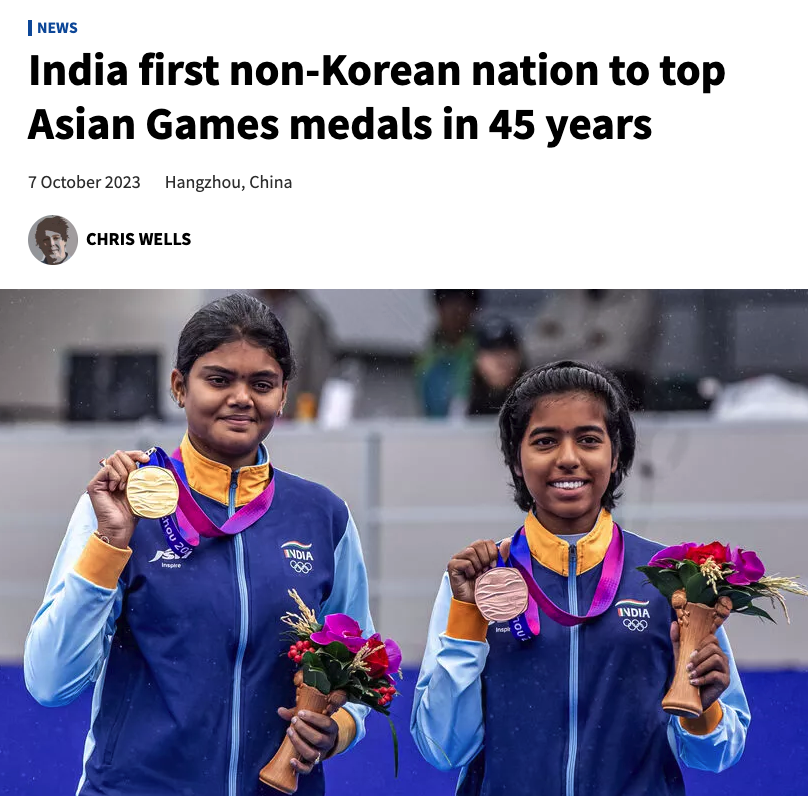
The Asian Games has more athletes (11,420 to the Summer Olympics’ 10,500), more sports (40 to 33) and massively more events (481 to 339). The TV audience is more limited, but ever growing, at a time when both Summer and Winter Games are seeing audiences shrink in Europe and North America. (It’s also a kind of proxy for actual war between its major players, but that’s another article). The IOC have long been concerned that the Asian Games’ huge size and increasing power have been a threat to their glittering prize.
This year’s edition, in Hangzhou in China – held over for a year due to COVID – was a no-expense-spared expression of soft power and global dominance, and rumoured to have cost anything between $30 and $40 billion dollars. (For comparison, the Tokyo 2020 Olympics cost $13bn.) Read this missive from the state if you want to get a Great Leap Forward-esque flavour of the priorities.
 Hangzhou main stadium
Hangzhou main stadium
Most people have never ever heard of Hangzhou, even though it is now a city of 10 million people and has 1500 years of history. A friend of mine working at the event texted me: “Expect the Olympics in Hangzhou in your lifetime. Once they sort out the airport it’s a banker. No western city can compete.” You might want to start reading about the Asian Century, if you’re so inclined.
It’s not the first time India’s compounders have performed well at the competition, but last time out, the teams were firmly in second place behind Korea and Chinese Taipei. Under Sergio Pagni’s instruction, they have reached the top. The decimation of the vastly better-funded Korean compound team this year will be causing nightmares in Jincheon. (Pity poor Reo Wilde, brought in in February solely to win Asian Games golds. It’s now looking like his tenure might be very short.)
The five-gold shutout in Hangzhou, if it could be properly harnessed by the Archery Association Of India and the IOA – neither of whom are exactly known for excellence in governance – could provide a massive groundswell of support for the discipline, if it looks like the 2036 Games will be going to India and there’s a bunch of golds for the taking. It’s still a long, long way off, and the decision is not entirely in their hands. But if compound is ever to make the Olympics, it might just be India who gets it there.
The post Compound: the dream is dead. For now. appeared first on The Infinite Curve.



